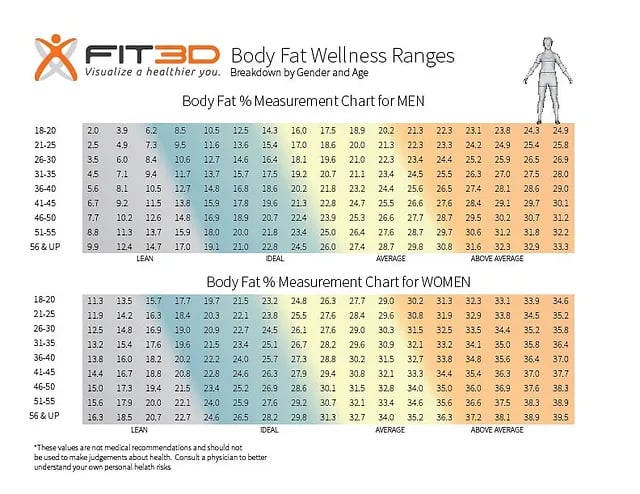A deep dive into how Fit3D calculates body fat using proprietary algorithm.
What is Fit3D Body Fat & where did it come from?
Fit3D’s proprietary body fat algorithm is our own.
To build it, we partnered with Mount Sinai, University of Hawaii, UCSF, LSU, and DexaFit. We had subjects take Fit3D scans as well as DXA scans, which we believe to be the gold standard in body fat assessment.
We captured this data on more than 20,000 subjects across several countries. We then looked to algorithmically correlate anthropometric measurements, which are automatically calculated by Fit3D, to the body fat readings from the DXA scans. You can read more about the results in this NIH paper, Clinical anthropometrics and body composition from 3D whole-body surface scans., and this writeup featuring our research with Mount Sinai.
How should I interpret Body Fat % results?
The chart below shows a fantastic breakdown of wellness ranges broken down by gender and age. This chart was created directly by our partners at DexaFit.

Why is my Body Fat % increasing?
Your body fat percentage is your fat mass divided by total mass. Lean mass is made up of everything that is not fat, your muscles, bones, and organs. So, if you’re noticeably decreasing your total mass, while your fat mass stays the same, your body fat percentage will increase.
Even if your fat mass is decreasing, total mass is decreasing faster, resulting in an increase of body fat percentage.
A little deeper dive into the details.
At Fit3D, we work with UCSF, LSU, and the Icahn School of Medicine at Mount Sinai to continue to produce the innovative Fit3D body fat algorithm. Please feel free to review the more specific details through our blog post, here.
As we get new control data in, which comes in at a rate of about 150 - 200 per month, we revise our algorithm and regress it against all scans in our dataset. If the data shows a material improvement, then we strategize the new algorithm's release.
Is there a case study I can reference?
Clinical anthropometrics and body composition from 3D whole-body surface scans
This study was published in the European Journal of Clinical Nutrition. We revised the algorithm a bit from here and will re-publish with the new algorithm through our collaboration with Mount Sinai Hospital when it is released.
Do body implants affect results?
Yes. We have no way of knowing what is under the skin and so because our algorithm is primarily volumetric/anthropometric based and assumes natural bodies, implants will affect the body composition numbers in an unnatural way.
"The Fit3D Body Composition results are different than what I'm used to..."
Body composition is almost like religion. The only real way to ascertain accuracy is through cadaver studies and therefore people generally use what they know. Please see this post from Body Spec (A mobile DXA company) to further explain:
How does the Fit3D body fat algorithm do for extremely lean athletes?
As with most forms of body composition testing, extremely lean athletes are underrepresented in studies as is the case with us. While we do a "good" job of assessing body fat for the very lean population, our current algorithm will over represent them on average. This is further exacerbated because many lean people have a misunderstanding of how much body fat they actually have. If a leaner person, used to more readily available devices, were to take a DXA test, I would assume that they would be between Fit3D and Bod Pod in body fat. Furthermore, future releases of our body composition algorithms will continue to perform better as we aggregate additional control data.
Why you do not use the calculations being used by other technologies? SIRI, Brozek, etc.? Similar volume-based equations?
We looked closely into different options and have done studies, but find that equations like Siri and Brozek are over simplified and are not actually good determinations of body fat across populations. This is why we correlated directly with DXA vs. bod pod or bio-impedance. The other challenge that we face is that hair is "volume" in our system, so unless people are wearing swim caps, the volume of the head is quite a bit larger than in real life. Again, because volume based equations are so simple, any slight variation will cause undesired inaccuracies.
